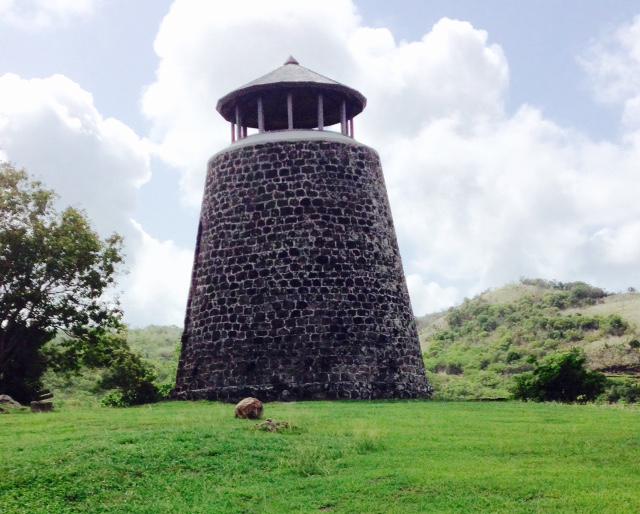About
Type: Ruin
Parish: St.Mary
Founding date: 1680
See on Google Maps!

Current Status
There is no longer a mill on this site, and there being extremely dense bush, it was impossible to look for further footprints of plantation habitation.
Estate Related History/Timeline
1673: George Turney 132 acres granted by Sir James Russell. The 1777-78 map by John Luffman shows “Mill Hill” but not the owner. “1780 Lockhart Russell rated on 199 acres..”
1676: Hon. Lieut.-Col. Randolph Russell was granted 511 acres in Antigua by Col. Philip Warner (his cousin). 1678 – Valentine Russell granted a patent for 511 acres in Falmouth.
1680: Sir James Russell and Nicholas Raynsford granted a patent for 1050 acres and a further grant of 100 acres of flashings.
1688: Sir James Russell Will to “my 3 daughters 1/2 my estate in Antigua and the other 1/2 to my wife, she to be the Ex’trix.”
1767: James Russell rated on 300 acres and 153 slaves (St. Mary’s Vestry Book)
1773: Indenture “….. all that plantation called Young’s Lane of 40 acres in the Parish of St. Mary’s, Antigua, and 175 slaves upon it and their other plantation in the div. of Old Road in Antigua …. (between Lockhart Russell and John Russell). 1790: “1790 on p.609 of the `Gent Mag’ is an account of the plot among the slaves on the plantation of the Hon. Lockhart Russell.” Vere Oliver Vol.III p.65
Francis Russell of Blackhall, co. Kincardine N.B owner of “Mill Hill” of 333 acres and “Gardeners” in Old Road, Antigua, which he inherited from his uncle Lockart Russell.
1807: Francis Russell “to my wife Mary Bannerman, al’s Russell, all my estate of Mill Hill and Gardiners in Old Road Division.” Vere Oliver Vol.III p.61/62
1829: Consisted of 333 acres and 178 slaves. Owned by Mary Russell.
1852: “Mill Hill” is in St. Mary’s Parish and, in 1852, contained 333 acres and was owned by Edward Lipscombe.
Legacies of British Slave-ownership: Mill Hill was awarded 2301 lsd 15s 3d for 161 enslaved. The awardees were Mary Russell, John Grant’s other association, and unsuccessful was George Fraser.
1864: June 15, 1864, 20,160 gallons of water piped daily to St. John’s from spring in the area. Vere Oliver Vol. I p.civi
1864: “The daily yield of water from the three principal springs, all situated about six miles from St. John’s, was measured during a period of drought. The water from these springs was collected and carried by pipes to a large reservoir situated at Barnes Hill to the southwest of St. John’s, where it has been distributed all over the city. Sawcolts – 12,960 gals. Mill Hill – 20,160 gals. Breaknocks – 8,640 gals.” Vere Oliver Vol. I p.civi
1878: Almanac shows Mill Hill of 392 acres belonging to Thomas B. Kirwin. Windmill.
1941: Antigua Sugar Factory Ltd Cane Returns for 1941 Crop. Mill Hill & Wallings. Estimated 650 tons – acres estate – acres peasants on the estate, tons of cane delivered 510.
Enslaved People’s History
Based on contemporary research, we have little information to share about the enslaved peoples from this plantation at this time. We do know that Mill Hill was awarded 2301 lsd 15s 3d for the liberation of 161 enslaved persons right after the abolition of slavery in England. Before that, there had been as many as 175 enslaved people working at this estate. We will continue our quest for more information about these vital individuals.
Ownership Chronology
- Ownership from 1680 Sir James Russell (d.1688)
- 1760: Lockhart Russell.
- 1760: Francis Russell (d.1807). Nephew of Lockart Russell.
- 1829: Mrs. Mary Russell. 178 slaves.
- 1843: F. Lipscombe.
- 1852: Edward Lipscombe.
- 1870: Joseph F. Smith.
- 1872: Heirs of Joseph F. Smith.
- 1872: Horsford Almanac
- 1878: Thomas B. Kirwin..
- 1933: James Francis.
- 1933: Camacho map